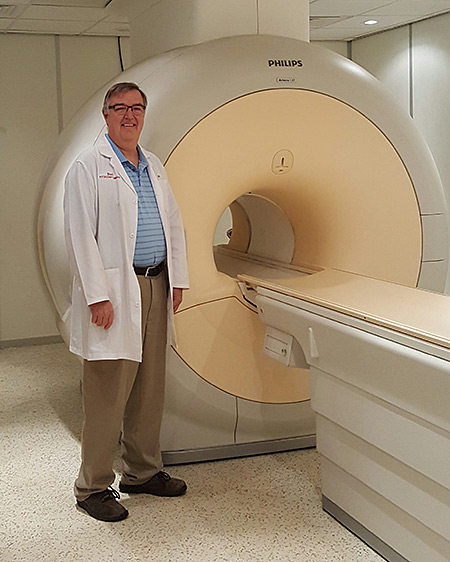Jun. 16, 2016
 Because it is so common to receive magnetic resonance imaging here at home, it’s easy to forget that this modality is brand new or nonexistent in other parts of the world. Recently, I was able to be a part of bringing this important technology to Black Lion Hospital in Addis Ababa, Ethiopia, as a Siemens ASRT Foundation Community Outreach Fellow in partnership with RAD-AID International.
Because it is so common to receive magnetic resonance imaging here at home, it’s easy to forget that this modality is brand new or nonexistent in other parts of the world. Recently, I was able to be a part of bringing this important technology to Black Lion Hospital in Addis Ababa, Ethiopia, as a Siemens ASRT Foundation Community Outreach Fellow in partnership with RAD-AID International.
Black Lion Hospital is an 800-bed teaching hospital that serves 4.5 million people. Until mid-January of this year, the hospital only provided radiography, computed tomography and ultrasonography imaging. That started to change when the hospital installed a Philips Achieva 1.5T MR system. With its installation, it became the second MR system in the capital city after another that is located in a privately owned facility.
Installing the equipment was the first step in improving patient care at the facility; however, the six radiologic technologists and 18 residents at the hospital needed to be trained how and when to use the new system. RAD-AID and the ASRT Foundation, who have partnered together before to help elevate health care in developing countries all over the world, once again stepped up.
Through a generous grant by Siemens to the Foundation, I had the opportunity to be a part of changing the lives of the people of Ethiopia. I was selected to provide additional resources and education on basic MR physics, protocol selection and clinical recognition of pathology. In addition, I provided MR safety education and the policies and procedures that would help ensure the department consistently produced high-quality images.
Prior to my arrival, the six Ethiopian technologists I would work with received two weeks of applications training from Philips, which enabled me to provide more in-depth training because I didn’t have to train them on the basics of operating the system. Working 12-hour days gave me the time I needed to observe and assist them, as well as providing the information that would help them in their daily scanning.
The sheer number of patients at the hospital made it necessary that I train the technologists as they saw patients. Sick patients lined the halls in wheelchairs and stretchers, some standing and some lying on the floor, waiting their turn to be examined. Many of them waited for hours and hours before they could be seen by a health care professional. On one day alone, 34 patients were scanned, and in the three weeks I was there, approximately 300 patients were scanned.
Because Black Lion Hospital is the only specialized referral center in Ethiopia, patients come there from all over the country. These individuals, who tended to be very poor, couldn’t afford to go to the doctor for what we might consider a routine exam for a small ailment. They had to be practically unable to work or function before they sought medical care. Because of that, these individuals tended to have extremely aggressive pathologies. While in the U.S. I might see one abnormal case for every 50 or so scans, there it was just the opposite: one “normal” case in every 50.
One of the projects I worked on had to do with identifying pregnancies with a high risk of delivery complications due to a small pelvic outlet; complications at the time of delivery are a prominent issue in the region. It was a challenge to come up with a good and reliable protocol that could be followed quickly due to the difficulty of late-term patients lying on their backs for any length of time. But by the time I left, a four-sequence protocol had been developed that took about six minutes to complete. My time at Black Lion Hospital was a once-in-a-lifetime experience for me. I saw firsthand how the things we find routine can vastly change the care patients receive there.
I returned home knowing that the improvements put in place through RAD-AID and the ASRT Foundation will continue. RAD-AID is now working to bring in a picture archiving and communication system (PACS) that will facilitate patient diagnosis better than the current process of putting images on compact discs to be viewed somewhere else. The 12 copies of the MRI Basics video series the ASRT Foundation donated to the hospital are a wonderful resource for the technologists.
I plan to continue working with the chief technologist at Black Lion to help him improve the functionality of the department. Throughout our many discussions, he came to see the value of standardizing all aspects of the MR department, from scheduling and contrast administration to implementing and following examination protocols. I also plan to help him develop an appropriate procedure and protocol handbook.
I am extremely grateful to Siemens for making this opportunity possible with their gift to the Foundation. My experience is but a drop in the bucket of the great work Foundation donors make possible with their support. Because of these amazing donors, medical imaging and radiation therapy professionals are able to take the high practice standards we have in the U.S. into developing countries. This helps to improve health care systems around the world and save countless lives.
I urge members of the R.T. community to continue their support of the Foundation. Its programs and partnerships truly are making it possible for us to reach more of the thousands of patients who are in need of the lifesaving procedures the radiologic sciences provide.